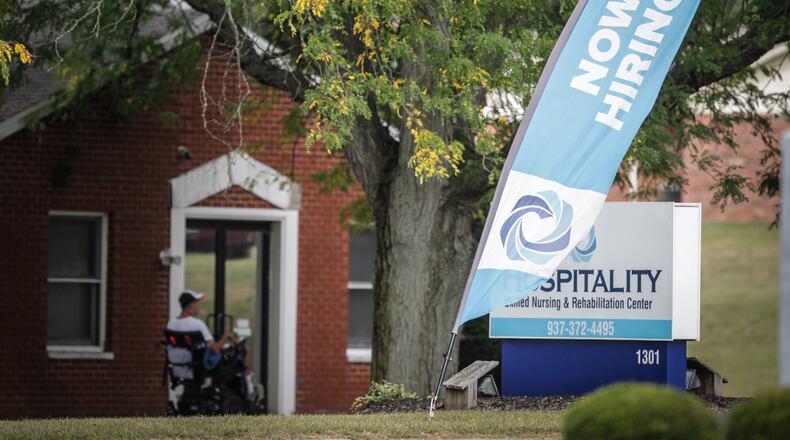The nursing home job market is there and many people need jobs, but there are now additional burdens now on these workers, said Patrick Schwartz, spokesman with LeadingAge Ohio, which represents nonprofit nursing homes and other long-term care providers.
“Long term care workers now have to limit their conduct in the community, they have to watch everything they do, they have to submit to regular testing, they have to wear PPE all day,” Schwartz said. He also said there can be a spike in fear among staff when there’s a positive case.
The job now has higher feeling of risk and more pressure, said Robert Applebaum, with Scripps Gerontology Center at Miami University, who recently helped author a paper on retention and turnover.
“It’s high touch care. It’s very difficult to social distance when you’re helping somebody dress when you’re helping somebody, or helping somebody use the bathroom,” Applebaum said.
With families held out of the facility, that can also place added pressure on the workers, Applebaum said.
On top of that, some nursing homes struggled, particularly at the beginning of the pandemic, to secure enough masks and gowns and other personal protective gear, which adds to the pressure of caring for a fragile population.
All these things together have contributed to the staffing issues that were already a problem," Applebaum said.
In his research paper studying turnover and retention, with a sample of 536 Ohio nursing homes, representing just over 60% of Ohio facilities operating in 2015, the average annual aide turnover rate in 2015 was 54.7% and the average annual aide retention rate was 63.8%.
Pete Van Runkle, CEO of Ohio Health Care Association, which represents nursing homes, said on top of these pressures of testing and masks and COVID-19, some workers also have pressures at home, such as a child at home distance learning who needs child care.
“We don’t have any statistics. But just anecdotally, we hear that there’s more turnover now than there was before,” Van Runkle said.
It’s a low paying job but one of the challenges with raising wages is that facilities have a difficult time raising more revenue. Many residents are paying with Medicaid or Medicare. Schwartz said pandemic has squeezed budgets, with additional expenses and also the number of paying residents declining as people opt not to live in long-term care communities or don’t have surgeries so don’t get discharged to the facilities.
Chip Wilkins, Dayton-area long-term care ombudsman, who advocates for nursing home resident rights, said it’s hard to work with facilities on institutional change when the leadership turnover means he never knows who he will be talking with when he calls for an administrator.
Turnover is also an issue among leadership at the facilities. Turnover of facility administrators and directors of nursing occurred in 27% and 35% of facilities, respectively.
Wilkins said the administrative turnover has been a long standing problem in the nursing home community, but he does think the pandemic exposes how vital having consistent administration relates to good care.
“Every administrator comes in with their agenda, policies and procedures and it usually takes a while to get everyone to buy into their vision for that facility," Wilkins said. "A lot of time they will pull the plug right when the work that has been going on is about to be fruitful, they switch and go to someone else and it starts all over again.”
Since most nursing home residents are paying with Medicaid or Medicare, the facilities are limited in how much they can raise additional revenue -- and this fixed budget can then make it hard to raise wages to attract and hold onto staff better.
Administrators leave for a variety reasons. Sometimes the change follows a significant complaint by a government inspector. Nursing homes frequently get new owners or new management groups as well and they sometimes bring in their own leadership when they take over. Also, when the facility’s number of residents gets low, sometimes the management will dismiss the administrator and hire a new one to see if that turns around the trend.
Applebaum said there’s a link between lower director of nursing turnover and lower aide turnover, which is a a sign of the benefits of investing in facility leadership.
It is difficult to generalize the rate of employees leaving though, because turnover and retention can widely vary by facility.
For example, researchers found a higher proportion of psychiatric residents was associated with higher turnover, suggesting that better training, supervision, and mentoring in working with this population of residents could have an impact on aides.
About the Author
